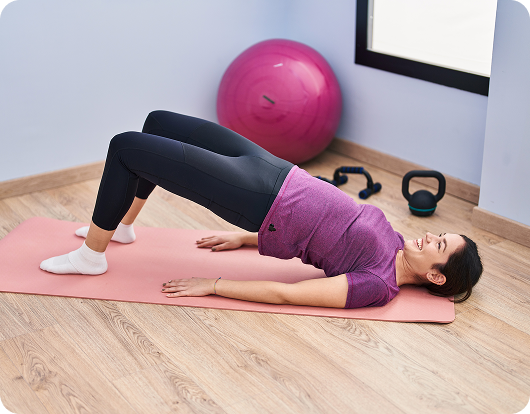Pelvic Floor Exercises for Incontinence
Strengthen your core muscles to improve bladder control and live with confidence.

Understanding How Pelvic Floor Exercises Help
Pelvic floor exercises help strengthen the muscles that control bladder and bowel function. Also known as Kegel exercises, these targeted movements enhance pelvic muscle performance and are effective for reducing symptoms of incontinence.
Both men and women can benefit from pelvic floor exercises, as they can help reduce leakage, improve bladder and bowel control, and support overall pelvic health when performed regularly.
Understanding How Pelvic Floor Exercises Help
Pelvic floor exercises help strengthen the muscles that control bladder and bowel function. Also known as Kegel exercises, these targeted movements enhance pelvic muscle performance and are effective for reducing symptoms of incontinence.
Both men and women can benefit from pelvic floor exercises, as they can help reduce leakage, improve bladder and bowel control, and support overall pelvic health when performed regularly.

Understanding Pelvic Floor Exercises
Pelvic floor exercises are designed to strengthen and tone the muscles that support your pelvic organs over time.
These muscles provide support to organs like the uterus (in women), bladder, small intestine, and rectum. When properly conditioned, they help you control urination, bowel movements, and even improve sexual function. Regular training can also support posture and lower the risk of pelvic organ prolapse.
Preparing for Pelvic Floor Exercises
Before starting, keep the following points in mind:
Identify the right muscles – The pelvic floor muscles are the ones you engage to stop urination mid-stream.
Find a comfortable position – Exercises can be done lying down, sitting, or standing.
Breathe normally – Avoid holding your breath. Steady breathing improves the effectiveness of the exercises.
Stick to a routine – Aim for three sessions per day, with at least three sets of 10 repetitions each time.
Empty your bladder first – Begin your session with an empty bladder to avoid discomfort.
Finding Your Pelvic Floor Muscles
Locating the correct muscles is essential. To do so, try to stop your urine mid-flow—those are the muscles you’re targeting (though this method shouldn’t be used regularly). Alternatively, imagine tightening the muscles used to stop passing gas or gently squeeze the muscles around your anus and vagina (for women) or base of the penis (for men).
You should feel a subtle lifting or tightening in your pelvic area. Avoid engaging other muscle groups like your abdomen, thighs, or buttocks. With regular practice, control and awareness of these muscles improve significantly.
Various Pelvic Floor Exercises
Incorporate these exercises into your daily routine for better pelvic strength and symptom relief:
Kegels
Tighten the pelvic floor muscles, hold for a few seconds, then release. Start with 10–15 repetitions and gradually increase the hold time as strength builds. These can be done in any position throughout the day.
Bridge
Lie on your back with knees bent and feet flat. Lift your hips, engaging your glutes and pelvic floor. Hold briefly, then return to the floor. Repeat as needed.
Squats
With feet hip-width apart, lower into a shallow squat while keeping your back straight. On your way up, contract your pelvic floor muscles to increase their strength.
Squeeze & Release
Quickly contract and relax your pelvic floor muscles without holding. Rest 3–5 seconds between reps. Aim for 10–20 reps per set. This helps train your muscles for quick responses.
Why Patients Trust Northwest Continence Center
We take a science-based, compassionate approach that puts your comfort and results first.
Advanced Axonics Therapy
A minimally invasive solution that restores nerve communication for lasting relief.
Personalized, Science-Based Care
Every treatment plan is tailored to your unique needs using proven medical approaches.
Experienced, Specialized Providers
Our experts are trained in continence-focused procedures and neuromodulation techniques.
Judgment-Free Patient Support
We create a respectful, compassionate environment where you feel safe and heard.
We’re More Than Just a Clinic
We understand that incontinence can be emotional and isolating. That’s why we’re committed to making your experience safe, respectful, and empowering. Every visit is designed to make you feel heard and supported.

Let’s find the right solution together.